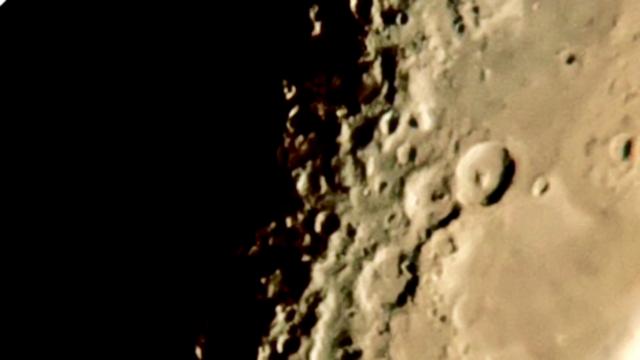- This topic has 6 replies, 6 voices, and was last updated 4 years, 4 months ago by
 Alan Thomas.
Alan Thomas.
-
AuthorPosts
-
27 July 2021 at 2:28 am #575014
 Tor SchofieldParticipant
Tor SchofieldParticipantThe present most widely accepted theory of how the Moon was formed, just doesn’t make sense. There seem to be two major stumbling blocks: why if the Earth was hit by a large impactor was it not destroyed of knocked out of its orbit; and far more crucial, why isn’t the Moon made of material from the impactor, when its geology suggests its composition is very similiar to Earth.
Attachments:
27 July 2021 at 10:16 am #584522 Andy WilsonKeymaster
Andy WilsonKeymasterHi Tor,
The detail of the theory explains both of these problems. Indeed I believe that the Earth and Moon have similar surface compositions is one of the key lines of evidence for the theory.
First, this happened during the formation of the solar system, when there may have been more planets than we find in the solar system today. The proto-Earth and its impactor, another protoplanet probably of similar size to Mars, would have been in similar orbits. The planets would interact gravitationally which could shift them into different orbits, eject one of the protoplanets out of the solar system, or as in this theory the protoplanets collided. The merged planet and moon would follow a similar orbit around the Sun to the original protoplanets. It is worth noting this orbit isn’t necessarily exactly where the Earth and Moon are found today as gravitational interactions between the planets were common in the early solar system, before the planets settled into the orbits we find today.
In the massive impact, the outer surface of the proto-Earth and the impactor would get mixed together. Some of this material would be ejected into space, settle into an orbit around the Earth and coalesce to form the Moon. Hence the surface of the Earth and Moon are similar compositions, a blend of the proto-Earth’s surface and the impactor. You can get a better idea from this video.
https://www.youtube.com/watch?v=BoU9OA92trA
Best wishes,
Andy
27 July 2021 at 4:42 pm #584523 Grant PrivettParticipant
Grant PrivettParticipantI was under the impression that the Apollo samples suggested that a significant portion of the lunar surface was formed from materials that were originally part of the Earth’s mantle. The lunar interior is rather harder to sample, though it does have a fascinating gravity field.
The magnetic fields are also very different.
27 July 2021 at 11:13 pm #584527 Dominic FordKeymaster
Dominic FordKeymasterThe giant-impact hypothesis was widely popularised as a direct result of the Apollo samples, most notably by Hartmann & Davis in 1975.
It seems very likely that the Moon has a fairly uniform composition all the way down, because its physical density is compatible with that. And its lack of magnetic field also suggests there isn’t any metallic core at the Moon’s centre.
That is quite suggestive that the Moon is indeed a big chunk of Earth mantle which got knocked off at some point. It’s hard to think of another way to form the Moon with such a similar composition to the Earth’s mantle, but systematically missing all the siderophillic metals which the Earth has in its core.
The theory goes that the impacting body would have been entirely melted / vapourised in the collision, and got thoroughly mixed with the (now molten) Earth’s mantle before the mixture divided into the Earth and Moon. That bit of the theory is certainly the weakest link, and people still run computer simulations and argue about how possible it is. It’s hard to make it work – but not impossible, with a finely-tuned oblique collision.
But as things stand, the debate is basically over the details of the impact geometry. Nobody has yet presented any credible alternatives to the broad outline of the Hartmann & Davis model, despite it seeming to require extreme fine-tuning to give the right result.
I think Andy has already answered the question about the Earth’s orbit. Yes, the Earth’s orbit will have changed. But it found a new orbit. In the solar system’s early history, that would have been commonplace.
28 July 2021 at 1:59 am #584528 Dr Paul LeylandParticipant
Dr Paul LeylandParticipantAndy has already addressed your second issue.
As for the first: the impact wasn’t big enough to destroy the Earth but was big enough to cause fatal damage to the significantly smaller impactor. What makes you think that the Earth’s orbit wasn’t changed by the collision from what it was into what it is now?
28 July 2021 at 2:27 am #584529 Dominic FordKeymaster
Dominic FordKeymasterIn the past, I think people did indeed tend to sweep the question of where the impactor went under the carpet.
In the past 10-20 years, it’s become possible to do full hydrodynamical simulations, and that’s where things start getting awkward. You need a pretty big impactor to knock a Moon-sized chunk out of the Earth. And in the vast majority of orientations, most of the impactor ends up in the Moon, with relatively little in the Earth. That totally mucks up the Moon’s composition.
You can get it right, with precisely the right orientation. From memory, a low-velocity and fairly oblique impact. But, the skeptics would ask, what are the chances nature would manage to play exactly the right snooker shot?
In the new era of robotic exploration of the Moon, I suspect we’ll see a lot more debate about this. The Apollo missions returned lots of rock from a small number of sites, and some people question how representative they actually are.
28 July 2021 at 5:35 pm #584533 Alan ThomasParticipant
Alan ThomasParticipantThe skeptics could be reminded that nature organised the distances and diameters of the Sun and Moon so as to yield total solar eclipses – a seemingly highly improbable coincidence.
Alan
-
AuthorPosts
- You must be logged in to reply to this topic.

